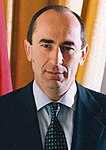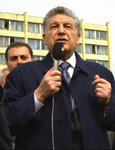
The politics of Armenia take place in the framework of the parliamentary representative democratic republic of Armenia, whereby the president of Armenia is the head of state and the prime minister of Armenia the head of government, and of a multi-party system. Executive power is exercised by the president and the Government. Legislative power is vested in both the Government and Parliament.

The history of Armenia covers the topics related to the history of the Republic of Armenia, as well as the Armenian people, the Armenian language, and the regions of Eurasia historically and geographically considered Armenian.

Vazgen Zaveni Sargsyan was an Armenian military commander and politician. He was the first Defence Minister of Armenia from 1991 to 1992 and then from 1995 to 1999. He served as Armenia's Prime Minister from 11 June 1999 until his assassination on 27 October of that year. He rose to prominence during the mass movement for the unification of Nagorno-Karabakh with Armenia in the late 1980s and led Armenian volunteer groups during the early clashes with Azerbaijani forces. Appointed defence minister by President Levon Ter-Petrosyan soon after Armenia's independence from the Soviet Union in late 1991, Sargsyan became the most prominent commander of Armenian forces during the First Nagorno-Karabakh War. In different positions, he regulated the military operations in the war area until 1994, when a ceasefire was reached ending the war with Armenian forces controlling almost all of Nagorno-Karabakh and seven surrounding districts.
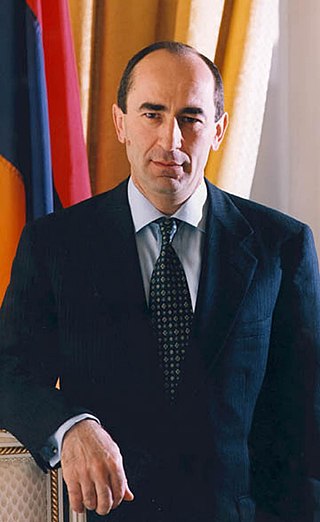
Robert Sedraki Kocharyan is an Armenian politician. He served as the President of the Nagorno-Karabakh Republic from 1994 to 1997 and Prime Minister of Nagorno-Karabakh from 1992 to 1994. He served as the second President of Armenia between 1998 and 2008 and as Prime Minister of Armenia from 1997 to 1998.

Levon Hakobi Ter-Petrosyan, also known by his initials LTP, is an Armenian politician and historian who served as the first president of Armenia from 1991 until his resignation in 1998.

Artsakh, officially the Republic of Artsakh or the Republic of Nagorno-Karabakh, was a breakaway state in the South Caucasus whose territory was internationally recognised as part of Azerbaijan. Between 1991 and 2023, Artsakh controlled parts of the former Nagorno-Karabakh Autonomous Oblast of the Azerbaijani Soviet Socialist Republic, including its capital Stepanakert. It had been an enclave within Azerbaijan from the 2020 Nagorno-Karabakh war until the 2023 Azerbaijani offensive, when the Azerbaijani military took control over the remaining territory controlled by Artsakh. Its only overland access route to Armenia after the 2020 war was via the 5 km (3.1 mi) wide Lachin corridor, which was placed under the supervision of Russian peacekeeping forces.

Karen Serobi Demirchyan was a Soviet and Armenian politician who served as President of the National Assembly in 1999 until his assassination. He had been also the First Secretary of the Communist Party of Armenia from 1974 to 1988. He was killed with other politicians in the Armenian parliament shooting.

Serzh Azati Sargsyan is an Armenian politician who served as the third President of Armenia from 2008 to 2018, and twice as the Prime Minister of Armenia from 2007 to 2008 and again from 17 to 23 April 2018, when he was forced to resign in the 2018 Armenian revolution.
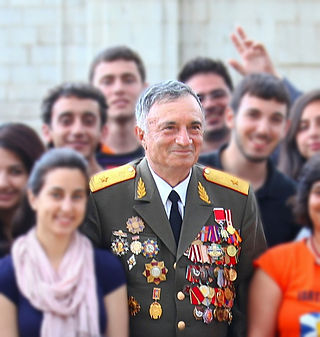
Arkady Ivani Ter-Tadevosyan, also known by his nom-de-guerre Komandos, was a Soviet and Armenian Major General, a military leader of the Armenian forces during the First Nagorno-Karabakh War and Armenia's former Deputy Minister of Defense. Ter-Tadevosyan is best known as the commander of the operation to capture the town of Shushi on 8–9 May 1992.

The 1999Armenian parliament shooting, commonly known in Armenia as October 27, was a terrorist attack on the Armenian National Assembly in the capital of Yerevan on 27 October 1999 by a group of five armed men led by Nairi Hunanyan that, among others, killed the two de facto decision-makers in the country's political leadership—Prime Minister Vazgen Sargsyan and Parliament Speaker Karen Demirchyan. Their reform-minded coalition had won a majority in a parliamentary election held in May of that year and had practically sidelined President Robert Kocharyan from the political scene.

Seyran Musheghi Ohanyan is an Armenian general and politician currently serving as a deputy in the National Assembly of Armenia. He served as Defence Minister of Armenia from 14 April 2008 until 3 October 2016. A native of Nagorno-Karabakh, he participated in both the first and second Karabakh wars, and from 2000 to 2007 served as defence minister of the unrecognized Republic of Artsakh.
Presidential elections were held in Armenia on 19 February 2008. Prime Minister Serzh Sargsyan was elected in the first round according to official results, but this was disputed by former President Levon Ter-Petrosyan, who was officially placed second.

The 2008 Mardakert clashes began on March 4 after the 2008 Armenian election protests. It involved the heaviest fighting between ethnic Armenian and Azerbaijani forces over the disputed region of Nagorno-Karabakh since the 1994 ceasefire after the First Nagorno-Karabakh War.

Presidential elections were held in Armenia on 19 February and 5 March 2003. No candidate received a majority in the first round of the election with the incumbent President Robert Kocharyan winning slightly under 50% of the vote. Therefore, a second round was held and Kocharyan defeated Stepan Demirchyan with official results showed him winning just over 67% of the vote. However, both the opposition and international observers said that the election had seen significant amounts of electoral fraud and the opposition did not recognise the results of the election.
Presidential elections were held in Armenia on 22 September 1996. The result was a victory for Levon Ter-Petrosyan, who received 51% of the vote. Turnout was 60%.
The Prague Process was a series of negotiations between 2002 and 2007 over Nagorno-Karabakh between the Armenian and Azerbaijani foreign ministries. It was followed by the Madrid Principles.
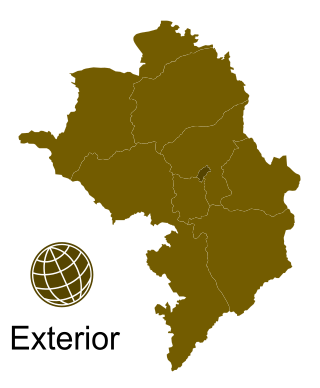
General elections were held in the Republic of Artsakh on 31 March 2020, with a second round of the presidential election on 14 April. Voters elected the President and 33 members of the National Assembly. It was the first time the President and National Assembly were elected at the same time.

Snap parliamentary elections were held in Armenia on 20 June 2021. The elections had initially been scheduled for 9 December 2023, but were called earlier due to a political crisis following the 2020 Nagorno-Karabakh War and an alleged attempted coup in February 2021.
During its existence, the Republic of Artsakh and the United States did not have official diplomatic relations as the United States was among the vast majority of countries that did not recognize Artsakh as a sovereign nation and instead recognized the region of Artsakh, or Nagorno-Karabakh, as part of Azerbaijan. Despite no formal relations, the Republic of Artsakh had a representative office in Washington, D.C. since November 1997. It is not known whether the office still functions after the apparent dissolution of Artsakh.

